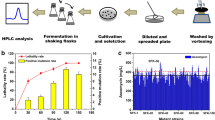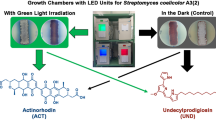Abstract
Femtosecond laser irradiation technology was employed for the first time to improve the ascomycin (FK520) yield of Streptomyces hygroscopicus var. ascomyceticus NT2-11, which is an N-methyl-N-nitro-N-nitrosoguanidine (NTG)-induced strain derived from S. hygroscopicus (ATCC14891). The mutant FS35 with high and stable FK520 production capacity was then obtained in the optimal irradiation conditions (25 mW for 6 min) by the Titanium sapphire laser system (810 nm, 76 MHz, 150 fs). The FK520 production capacity of FS35 was 45% higher than that of the parental strain NT2-11. Moreover, under the optimal fermentation conditions, FK520 fermentation titer of FS35 reached 300 mg/L and the intrinsic kinetics of FS35 and NT2-11 were investigated comparatively in 3 phases. The mathematical models provided a good description of FK520 fermentation process for both strains and valuable information for optimizing operation and pilotplant enlargement research. The comparative studies on parameters of the models confirmed the advantages in production and the decrease of substrate inhibition through femtosecond laser irradiation. Therefore, femtosecond laser irradiation provides a promising way to enhance the production of FK520 in S. hygroscopicus.
Similar content being viewed by others
References
Arai, T., Y. Kouama, T. Suenaga, and H. Honda (1962) Ascomycin, an antifungal antibiotic. J. Antibiot. 15: 231–232.
Dumont, F. J., M. J. Staruch, S. L. Koprak, J. J. Siekierka, C. S. Lin, R. Harrison, T. Sewell, V. M. Kindt, T. R. Beattie, and M. Wyvratt (1992) The immunosuppressive and toxic effects of FK-506 are mechanistically related: Pharmacology of a novel antagonist of FK-506 and rapamycin. J. Exp. Med. 176: 751–760.
Sierra-Paredes, G. and G. Sierra-Marcuõ (2008) Ascomycin and FK506: Pharmacology and therapeutic potential as anticonvulsants and neuroprotectants. CNS Neurosci. Ther. 14: 36–46.
Monaghan, P., M. Fardis, W. P. Revill, and A. Bell (2005) Antimalarial effects of acrolactones related to FK520 (Ascomycin) are independent of the immunosuppressive properties. J. Infect. Dis. 191: 1342–1349.
Revill, W. P., J. Voda, C. R. Reeves, L. Chung, A. Schirmer, G. Ashley, J. R. Carney, M. Fardis, C. W. Carreras, Y. Zhou, L. Feng, E. Tucker, D. Robinson, and B. G. Gold (2002) Genetically engineered analogs of ascomycin for nerve regeneration. J. Pharmacol. Exp. Ther. 302: 1278–1285.
Ji, X. J., H. Huang, and P. K. Ouyang (2011) Microbial 2, 3-butanediol production: A state-of-the-art review. Biotechnol. Adv. 29: 351–364.
Regentin, R., L. Cadapan, S. Ou, S. Zavala, and P. Licari (2002) Production of a novel FK520 analog in Streptomyces hygroscopicus: Improving titer while minimizing impurities. J. Ind. Microbiol. Biotechnol. 28: 12–16.
Demain, A. L. and J. L. Adrio (2008) Strain improvement for production of pharmaceuticals and other microbial metabolites by fermentation. Prog. Drug Res. 65: 251–289.
Wu, K., L. Chung, W. P. Revill, L. Katz, and C. D. Reeves (2000) The FK520 gene cluster of Streptomyces hygroscopicus var. ascomyceticus (ATCC 14891) contains genes for biosynthesis of unusual polyketide extender units. Gene. 251: 81–90.
Vogel, A., J. Noack, G. Hüttmann, and G. Paltauf (2005) Mechanisms of femtosecond laser nanosurgery of cells and tissues. Appl. Phys. B: Lasers Opt. 81: 1015–1047.
Gong, J. X., X. M. Zhao, Q. R. **ng, F. Li, H. Y. Li, Y. F. Li, L. Chai, Q. Y. Wang, and A. Zheltikov (2008) Femtosecond laserinduced cell fusion. Appl. Phys. Lett. 92: 093901.
Manevitch, Z., D. Lev, M. Hochberg, M. Palhan, A. Lewis, and C. D. Enk (2010) Direct antifungal effect of femtosecond laser on Trichophyton rubrum onychomycosis. Photochem. Photobiol. 86: 476–479.
Song, H., S. H. Jang, J. M. Park, and S. Y. Lee (2008) Modeling of batch fermentation kinetics for succinic acid production by Mannheimia succiniciproducens. Biochem. Eng. J. 40: 107–115.
Shang, L., D. D. Fan, M. I. Kim, J. D. R. Choi, and H. N. Chang (2007) Modeling of poly(3-hydroxybutyrate) production by high cell density fed-batch culture of Ralstonia eutropha. Biotechnol. Bioproc. Eng. 12: 417–423.
Kohli, R., B. Biplab, and G. P. Kumar (2001) Induction of phr gene expression in E. coli strain KY706/pPL-1 by He-Ne laser (632.8 nm) irradiation. J. Photochem. Photobiol. B: Biol. 60: 136–142.
Xu, Z. N., W. H. Shen, X. Y. Chen, J. P. Lin, and P. L. Cen (2005) A high-throughput method for screening of rapamycin-producing strains of Streptomyces hygroscopicus by cultivation in 96-well microtiter plates. Biotechnol. Lett. 27: 1135–1140.
Xu, W. M., S. Yang, P. Bhadury, J. He, M. He, L. L. Gao, D. Y. Hu, and B. A. Song (2011) Synthesis and bioactivity of novel sulfone derivatives containing 2,4-dichlorophenyl substituted 1,3,4-oxadiazole/thiadiazole moiety as chitinase inhibitors. Pestic. Biochem. Phys. 101: 6–15.
Andrews, J. F. (1968) A mathematical model for the continuous culture of microorganisms utilizing inhibitory substrates. Biotechnol. Bioeng. 10: 707–723.
Bajpai, R. K. and M. Reuss (1980) Mechanistic model for penicillin production. J. Chem. Tech. Biotechnol. 30: 332–344.
Luedeking, R. and E. L. Piret (1959) A kinetic study of the lactic acid fermentation:Batch process at controlled pH. J. Biochem. Microbiol. Technol. Eng. 1: 393–431.
He, L., Y. Q. Xu, and X. H. Zhang (2008) Medium factor optimization and fermentation kinetics for Phenazing-1-Carboxylic acid production by Pseudomonas sp. M18G. Biotechnol. Bioeng. 100: 250–259.
Wang, X., P. Xu, Y. Yuan, C. Liu, D. Zhang, Z. Yang, C. Yang, and C. Ma (2006) Modeling for gellan gum production by Sphingomonas paucimobilis ATCC 31461 in a simplified medium. Appl. Environ. Microbiol. 72: 3367–3374.
Hodge, J. E. and B. T. Hofreiter (1962) Determination of reducing sugars and carbohydrates. pp. 380–394. In: R. L. Whistler and M. L. Wolfrom (eds.). Methods in Carbohydrate Chemistry. Academic Press, NY, USA.
Lu, W. Y., J. H. Fan, J. P. Wen, Z. D. **a, and Q. G. Caiyin (2011) Kinetic analysis and modeling of daptomycin batch fermentation by Streptomyces roseosporus. Appl. Biochem. Biotechnol. 163: 453–462.
Botchway, S. W., P. Reynolds, A.W. Parker, and P. O’Neill (2010) Use of near infrared femtosecond lasers as sub-micron radiation microbeam for cell DNA damage and repair studies. Mutat. Res. 704: 38–44.
Essam, T., M. A. Amin, O. E. Tayeb, B. Mattiasson, and B. Guieysse (2010) Kinetics and metabolic versatility of highly tolerant phenol degrading Alcaligenes strain TW1. J. Hazard. Mater. 173: 783–788.
Onysko, K. A., H. M. Budman, and C. W. Robinson (2000) Effect of temperature on the inhibition kinetics of phenol biodegradation by Pseudomonas putida O5. Biotechnol. Bioeng. 70: 291–299.
Hatanaka, H., T. Kino, S. Miyata, N. Inamura, A. Kuroda, T. Goto, H. Tanaka, and M. Okuhara (1988) FR-900520 and FR-900523, novel immunosuppressants isolated from a Streptomyces II. Fermentation, isolation and physico-chemical and biological characteristics. J. Antibiot. 411: 1592–1601.
Author information
Authors and Affiliations
Corresponding author
Rights and permissions
About this article
Cite this article
Qi, Hs., **n, X., Li, Ss. et al. Higher-level production of ascomycin (FK520) by Streptomyces hygroscopicus var. ascomyceticus irradiated by femtosecond laser. Biotechnol Bioproc E 17, 770–779 (2012). https://doi.org/10.1007/s12257-012-0114-2
Received:
Revised:
Accepted:
Published:
Issue Date:
DOI: https://doi.org/10.1007/s12257-012-0114-2




